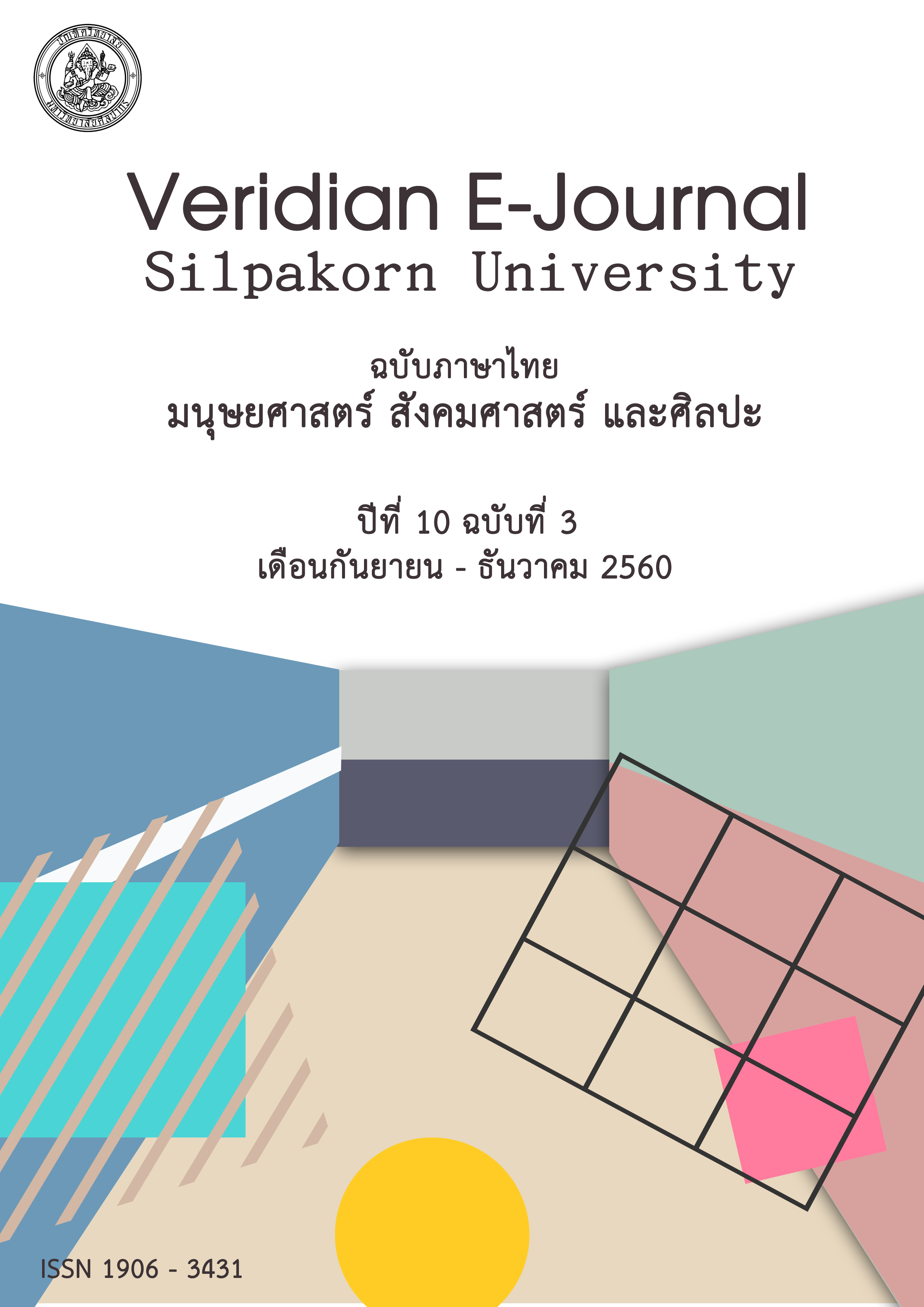ยุทธศาสตร์การส่งเสริมการทำนาหว่านน้ำตมเพื่อลดต้นทุนการผลิตของจังหวัดเพชรบุรี
Main Article Content
Abstract
การวิจัยนี้มีวัตถุประสงค์เพื่อ 1) พัฒนาชุดฝึกอบรมการส่งเสริมการทำนาหว่านน้ำตมในการลดต้นทุนการผลิตให้มีประสิทธิภาพ 80/80 2) เปรียบเทียบผลการทดลองในด้านความรู้ เจตคติ และทักษะระหว่างก่อนและหลังได้รับการฝึกอบรมด้วยชุดฝึกอบรมการส่งเสริมการทำนาหว่านน้ำตมในการลดต้นทุนการผลิต 3) ประเมินต้นทุนต่อผลผลิตในการทำนาหว่านน้ำตมระหว่างก่อนและหลังการได้รับการฝึกอบรมด้วย ชุดฝึกอบรมการส่งเสริมการทำนาหว่านน้ำตมในการลดต้นทุนการผลิตของกลุ่มตัวอย่างในการวิจัย ได้แก่ เกษตรกรที่ทำนาหว่านน้ำตมในเขตชลประทานในจังหวัดเพชรบุรี จำนวน 10 คน เลือกแบบเจาะจงเป็นกลุ่มตัวอย่าง เครื่องมือที่ใช้ในการวิจัย คือ ชุดฝึกอบรมการส่งเสริมการทำนาหว่านน้ำตมในการลดต้นทุนการผลิต แบบวัดความรู้ แบบสอบถามเพื่อวัดเจตคติ แบบสังเกตทักษะในการทำนาหว่านน้ำตม แบบสัมภาษณ์เพื่อเก็บรวบรวมข้อมูลต้นทุนและผลผลิตในการทำนาหว่านน้ำตม สถิติใช้ในการวิเคราะห์ข้อมูล คือ ค่าร้อยละ ค่าเฉลี่ย ส่วนเบี่ยงเบนมาตรฐาน และการวิเคราะห์เนื้อหา
ผลการวิจัยพบว่า
- ผลการหาประสิทธิภาพของชุดฝึกอบรมการส่งเสริมการทำนาหว่านน้ำตมในการลดต้นทุน การผลิตมีประสิทธิภาพสูงกว่าเกณฑ์ที่กำหนด คือ 13/84.00
- ผลการเปรียบเทียบการทดลองใช้ชุดฝึกอบรมการส่งเสริมการทำนาหว่านน้ำตมในการลดต้นทุนการผลิตประกอบด้วย 5 เรื่อง ได้แก่ 1) การเตรียมดิน 2) การเตรียมเมล็ดพันธุ์ 3) การลดการใช้ปุ๋ยเคมี 4) การลดการใช้สารเคมี 5) การดำเนินการจริงการทำนาหว่านน้ำตม ในการลดต้นทุนการผลิต ผลการทดลองทำให้ผู้เข้ารับการฝึกอบรมมีคะแนนเฉลี่ยด้านความรู้ เจตคติ และทักษะหลังเข้ารับการฝึกอบรมสูงกว่าก่อนเข้ารับการฝึกอบรม อย่างมีนัยสำคัญทางสถิติที่ระดับ 01
ผลการประเมินต้นทุนและผลผลิตในการทำนาหว่านน้ำตมในการลดต้นทุนการผลิต ระหว่างก่อนและหลังการฝึกอบรมของกลุ่มทดลอง มีความแตกต่างกัน โดยหลังเข้ารับการฝึกอบรมมีต้นทุน ต่ำกว่าก่อนเข้ารับการฝึกอบรม และมีผลกำไรสูงกว่าก่อนเข้ารับการฝึกอบรม เป็นเงิน 1,265.08 บาทต่อไร่ และที่สำคัญควรมีการรวมกลุ่มเกษตรกรเพื่อร่วมมือกันจัดทำหรือจัดทำปุ๋ยและหาแหล่งจำหน่วยปุ๋ยในราคาต่ำหรือในราคาต้นทุนและ มีคุณภาพสูงให้กับเกษตรกรที่มีปัญหา ที่จะนำวิธีการทำนาหว่านน้ำตมใน การลดต้นทุนในการผลิตไปใช้ในการทำนาของเกษตรกรในฤดูกาลต่อไปอย่างยั่งยืน
this research aiming to: 1) develop the training toolkit for promoting rice production by wet direct seeding to reduce production cost with efficiency at 80/80, 2) compare the experiment results in the aspects of knowledge, attitude, and skills, existing before and after the training by using the toolkit for promoting rice production by wet direct seeding to reduce production cost, and 3) evaluate production cost and product in rice production by wet direct seeding existing before and after the training by using the toolkit for promoting rice production by wet direct seeding to reduce production cost. The research samples were 10 farmers practicing the wet direct seeding in rice production in the irrigated areas in Phetchaburi Province, selected by using purposive sampling method. The research instruments were the training toolkit for promoting rice production by wet direct seeding to reduce production cost, the knowledge test paper, the observation form for observing the skills on wet direct seeding, and the interview form for collecting the data on production cost and product of rice production by wet direct seeding. The data were analyzed by using percentage, mean, standard deviation, t-test, and content analysis.
The research results were as follows:
- The efficiency of the training toolkit for promoting rice production by wet direct seeding to reduce production cost was at 83.13/84.00, higher than the set criteria.
- The training toolkit for promoting rice production by wet direct seeding to reduce production cost consisted of 5 aspects namely 1) soil preparation, 2) seed preparation, 3) reduction of chemical fertilizers, 4) reduction of other chemicals, and 5) actual performance of rice production by wet direct seeding to reduce production cost. The experiment results revealed that the trainees’ knowledge, attitude, and skills existing after the training were higher than those existing before the training with statistical significance at the 0.01 level.
The production costs and products existing before and after the training in rice production by wet direct seeding were different. The production cost existing after the training was lower than that existing before the training and the profit gained after the training was higher than that gained before the training, about 1,265.08 baht per rai (1,600 m2). Therefore, every relevant party should continuously cooperate in promoting the rice production by wet direct seeding to reduce the production cost.

